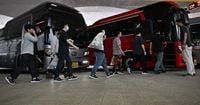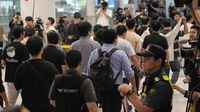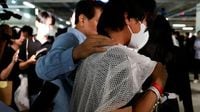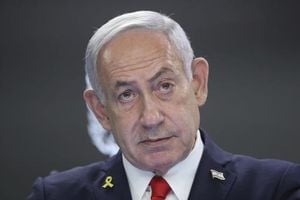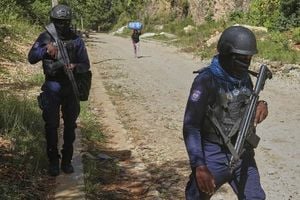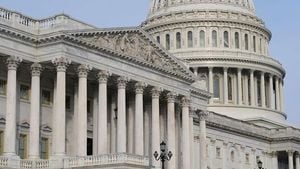On September 12, 2025, the arrivals hall at Incheon International Airport, just west of Seoul, was filled with a rare mix of relief, exhaustion, and simmering outrage. More than 300 South Korean workers, recently released after days of detention in Georgia, United States, stepped off a chartered Korean Air Boeing 747-8i and into the arms of their anxious families. Their journey home marked the end of an ordeal that has sent ripples through diplomatic, business, and immigration circles on both sides of the Pacific.
The workers were among roughly 475 people taken into custody during a September 4 immigration raid at a battery factory under construction on the sprawling campus of Hyundai’s auto plant in Ellabell, west of Savannah, Georgia. The facility, a $4.3 billion joint venture between Hyundai and LG Energy Solution, is just one of more than 20 major industrial projects South Korean companies are currently building across the United States, according to AFP.
What set this raid apart, and what ignited a firestorm of public anger in South Korea, was the release by U.S. authorities of video footage showing some of the detained Korean workers shackled with chains around their hands, ankles, and waists. The images sparked not only outrage but also an acute sense of betrayal in South Korea, a country that has long counted itself among America’s closest allies. As The Associated Press reported, the sight of fellow citizens in chains was a shock that reverberated far beyond the families directly affected.
When the workers arrived at Incheon, they were greeted by senior officials, including presidential chief of staff Kang Hoon-sik, who clapped and offered warm embraces. Hundreds of journalists crowded the terminal, jostling for photos and interviews, while ordinary citizens shouted, “Welcome back!” One protester unfurled a massive banner featuring a photo of U.S. President Donald Trump and a biting message criticizing U.S. immigration crackdowns, before security officials ushered him away. The South Korean Foreign Ministry, mindful of the workers’ privacy, asked media outlets to blur their faces in any broadcast images, citing the workers’ own requests.
The emotional reunions were raw and immediate. Families had waited for hours in the airport parking lot, uncertain until the last minute that their loved ones would be on the flight. Hwang In-song, whose brother was among the detainees, told The Associated Press that the past week had been “the hardest time” for their family. “We asked him if he was okay health-wise, and he said he was in good health. We didn’t get to talk much because he was about to board the plane,” Hwang recalled. Choi Yeon-ju, a 64-year-old mother waiting with her daughter-in-law and grandchild, described her son’s detention as “incredibly shocking and stunning.” Her son managed a brief call after midnight Thursday, simply telling them he was okay and urging them not to worry.
Of the 330 people on the flight, 316 were South Koreans, including a pregnant woman. The remainder were Chinese, Japanese, and Indonesian workers. All had been held at an immigration detention center in Folkston, Georgia, about 285 miles southeast of Atlanta. The conditions were reportedly harsh. One worker, speaking anonymously to AP, described the discomfort of sharing a cramped room with a toilet next to where they ate and slept. Another, Jang Yeong-seon, said, “No one would have really wanted to stay,” when asked about President Trump’s supposed offer to let workers remain at the factory to continue their tasks.
The process of bringing the workers home was anything but straightforward. South Korea announced on September 7 that it had reached an agreement with the United States for their release. However, the original plan to repatriate the workers on September 11 was abruptly shelved. According to South Korea’s Foreign Ministry, President Trump had intervened, pausing the departure to consider whether some workers should be allowed to stay and help train U.S. workers. In the end, only one South Korean national, who had relatives in the U.S., chose to remain.
President Lee Jae Myung, speaking at a news conference, explained, “President Trump had directed that the (detainees) should be allowed to return home freely and those who didn’t want to go didn’t have to. We were told that, because of that instruction, the process was paused and the administrative procedures were changed accordingly.”
The raid and its aftermath have cast a spotlight on the complex and often contradictory U.S. visa system, especially as it relates to skilled foreign workers. U.S. authorities claimed that some of the detained Koreans had crossed the border illegally, while others had entered legally but overstayed their visas or arrived on visa waivers that did not permit them to work. South Korean companies, under pressure to launch massive new facilities in the U.S., have long relied on short-term visitor visas or the Electronic System for Travel Authorization (ESTA) to send workers for setup tasks—a practice that, until now, had been largely tolerated.
But South Korean officials have grown increasingly frustrated, arguing that Washington has failed to act on repeated requests to improve the visa process for skilled workers. Foreign Minister Cho Hyun, who traveled to Washington to negotiate the workers’ release, said U.S. officials had now agreed to allow the workers to return later to finish their assignments. The two countries also plan to establish a working group to explore ways to ease the process for Korean companies sending employees to the U.S. “We will discuss all measures, including creating a new visa category, establishing a new quota, and various steps to make obtaining a visa easier,” Cho told reporters upon his return.
The timing of the raid only heightened tensions. It occurred about two weeks after a summit between President Lee and President Trump, and just over a month after South Korea announced a $350 billion investment plan in the U.S.—a move that had been widely seen as a sign of deepening economic partnership. Now, President Lee is warning that South Korean companies may hesitate to make further investments in the U.S. unless the visa system is improved. “Unless there is change, our companies will likely hesitate to invest further,” he cautioned publicly.
For many South Koreans, the episode has underscored the fragility of even the closest alliances when domestic politics and immigration enforcement collide. The mass detentions were part of the Trump administration’s broader agenda of workplace raids and mass deportations, a policy that has drawn both support and criticism within the U.S. and abroad. As the workers begin to rebuild their lives at home, and as both governments scramble to patch up the diplomatic fallout, the questions raised by this incident—about fairness, legality, and the real cost of international investment—are likely to linger well beyond the arrivals hall at Incheon.
For now, the workers are home, families are reunited, and the world is left to watch what comes next for both South Korea–U.S. relations and the global flow of skilled labor.
